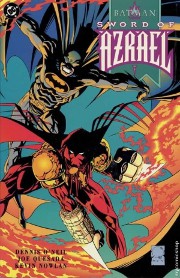Reading – Batman: Sword of Azrael
After looking at the DC Universe Classics Azrael Batman action figure last week (review here) I just had to pull out my copy of Batman: Sword of Azrael*. It had been several years since I had last read this story, and I love that I can report that I enjoyed the story as much today as I did back in 1992 while reading the mini-series as it was released one book at a time.
Many of you are already familiar with the entire Batman: Knightfall storyline*, but for those of you who are either too young to have read the books as they were released (or have just never bothered) the summary comes down to: Bruce Wayne is defeated and a new Batman, Azrael, steps up and then proceeds to get nasty.

Regardless of your thoughts on where the Knightfall storyline eventually led, I feel that this statement is unarguable: Batman: Sword of Azrael* is a wonderfully-written story packed with some of the best Batman artwork of the early nineties. Even today writer Dennis O’Neil’s dialogue is fun to read and artist Joe Quesada’s artwork (inked by Kevin Nowlan) is perfectly beautiful. At the time I knew Quesada was going to become a great comic artist, but I never would have imagined that he would have grown to lead Marvel to what it is today.
But Quesada’s tale is better left for a post about the must-own artbook, The Marvel Art of Joe Quesada*, so for now let’s keep our attention on the introduction of the controversial Azrael.
Walls of Text
One of the things that jumped out at me as I reread Batman: Sword of Azrael* was just how many words were crammed onto each page. In comics it’s usually a “less is more” when it comes to word count, but I think it’s evidence of O’Neil’s incredible skills as a comic author that make the number of words on every single page work beautifully. And even with lots of dialogue from numerous characters the lettering — using color-coded blocks as necessary to identify which character’s monologue is taking “screen” time in each section — makes it clear and easy to follow the story and the characters. Not once was I confused as to who was saying what; a common problem I’ve seen in some comics that try to pack too many words into each panel.
Page After Page of Great Artwork
The covers and interior pages shown here should give you a clear idea of just what the book looks like. Quesada has a distinctive style, and even in this book — which was my introduction to Joe Quesada — he’s developing his own art style. I often get feelings of Frank Miller’s Dark Knight Returns* when looking at earlier Quesada works, and the Batman’s appearance in this book drives that home more than almost anything else in early Quesada work. This shouldn’t be a shock — Quesada has been quoted many times as saying that Dark Knight Returns got him looking at comics again — and I’m not trying to say at all that this is a bad thing. In fact, the Miller influences in this book — especially some of the panel layouts — are part of what I think makes the book work so well.
Basically, the artwork is every bit worthy of O’Neil’s great writing.
A Perfect Addition to Any Bat Library
Even if you never go on to read (or reread) the Batman: Knightfall storyline* I think that this story is a must-own for any Batman or comic book fan. Even with all of the dialogue the story moves quickly, and the chance to see some of the earliest work of a now-legendary artist/creator makes Batman: Sword of Azrael* a classic. And at almost twenty years old — wow, I cannot believe that the story is nearly that old — I think it’s safe to call this a classic.
This may not be the first Batman book that I would insist that someone read, but it’s easily in my top ten. And that’s saying a hell of a lot when you think about how many truly incredible Batman books are out there.
I’m glad I pulled this off of the shelf again, and I suggest that you do so as well. It really is a fun read.







Nice to see Azrael’s fan base pop up now & again. I like the clinical nature of your reviews.
@Blaquesaber – Clinical? Ouch! “Okay, Batman, let’s get this review over with . . . “